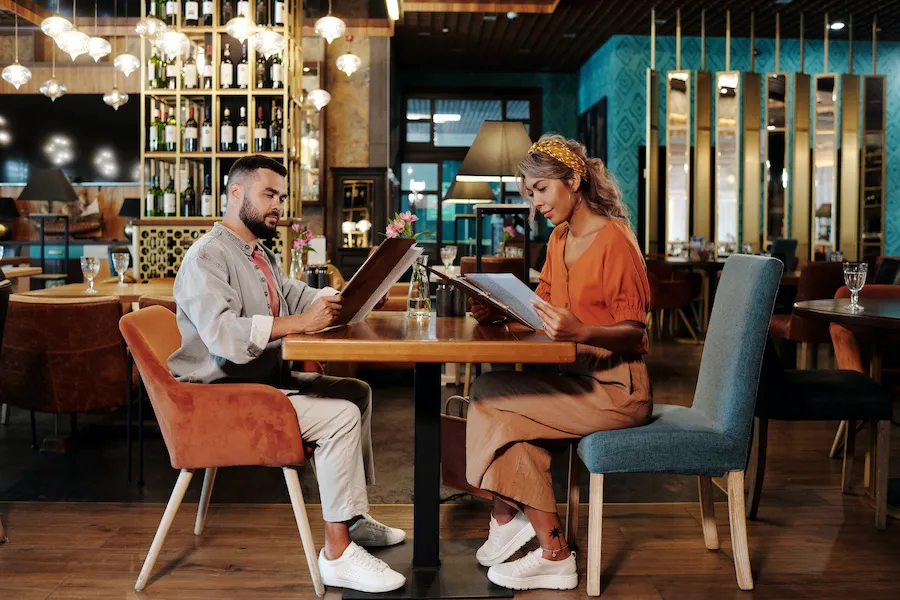Menu Engineering – How it can Help Increase Profits while Making you Cool
- Periodical evaluation of what items to retain or discard from the menu
- Conduct an objective review of menu item pricing
- Helps design a profitable menu and encourages constant menu monitoring
- Aids in positioning the menu items on the menu layout, based on the dual dimensions of popularity-profitability
- Encourages restaurant to review menu item recipe and portion sizes
- Craft your menu
- Categorize menu items according to profit and popularity levels
- Design your menu
- Test your new menu design

Food Cost and Contribution Margin
While, in the era gone-by, lack of technological tools, made cost analysis cumbersome; in this day and age most of the data needed for menu engineering analysis is captured by a Point-of-Sale system. In essence, whatever the scale of the restaurant and whether the investment in technological tools exists currently or not, it is wise to create the required spreadsheets or invest in the tools to get to the bottom of food costs. The primary metrics include:
- Menu Item Food Cost – Refers to the cost of each of the ingredients, used to create a dish. One way to complete this daunting task is to calculate the food cost of a single batch of a dish and to divide that by the number of portions one gets from that batch.
Menu Item Food Cost = (Cost of Each Ingredient + Cost of Purchasing)
- Total Food Cost Percentage and Menu Item Food Cost Percentage – While calculating the Total Food Cost Percentage, it is important to finalize the time period for such calculation. What is the total cost of making all the food one served in say, a quarter and what was the total sales in that same period?
Total Food Cost Percentage = (Total Food Cost/Total Sales) * 100
When the above formula is used to calculate the figure for a single menu item, it refers to Menu Item Food Cost Percentage = (Menu Item Food Cost/Menu Price) * 100
- Total Contribution Margin and Portion Contribution Margin – Calculated for a specific time period, Contribution Margin per Portion = (Menu Item Sale Price – Menu Item Food Cost)
When this is done cumulatively for all units/portions sold of that menu item, it refers to Total Contribution Margin Per Menu Item = (Total Revenue from Sales of Menu Item – Total Food Cost of making all units of Menu Item)
- Menu Item Popularity – Easiest of all the metrics to calculate, one only needs to see the number of units/portions of each menu item sold, to compare its popularity vis-à-vis other menu items within the same category. Periodically speaking to service staff about popularity of various items is also a good idea, to corroborate against system data.
What emerges from the above metrics is a classification of all the restaurant menu items into the categories of Stars, Puzzles, Plowhorses and Dogs. The categorization is the fundamental premise for menu design and layout; final decision-making on what menu items to retain and what to discard and arriving at an optimal menu mix to cater to the target segment.
- Stars (High Profitability and High Popularity) – Not only is the cost, well within limits, but these items are constantly in demand, with steady ordering of raw material replenishments to meet demand. These items should be placed in such a way on the menu card, as to draw immediate attention of the diner. Further, they don’t need any changes, either to the recipe or presentation. One could also test these items for price inelasticity – how much of a price increase is possible without impacting demand? Being high in demand, they are the best items to showcase in all media promotions, with high-quality photographs.
- Puzzles (High Profitability and Low Popularity) – These items have tremendous potential but for varied reasons, aren’t that popular. The strategy is to make these items delicious for the guests through:
- Reinventing the description of the product on the menu, to sound appetizing;
- Altering the recipe for better taste or enhancing the presentation for higher appeal;
- Introducing these items on special days, running a deal or discount for a period of time or as once a week special;
- Staff are probably aware, before anyone else on menu item popularity but staff can be trained to particularly recommend these items to guests.
- Plowhorses (Low Profitability and High Popularity) – These items are popular but not cheap to make, primarily due to high ingredient prices. The strategy here would be to negotiate for better prices with vendors or to look at vendors with more competitive pricing. Tweaking the portion size could be another way to decrease the cost, provided the current portion size is leading to wastage. Another prudent way to make up for its low profitability is to pair it with another item on the menu with a higher contribution margin.
Dogs (Low Profitability and Low Popularity) – Your menu engineering analysis is considerably focused on such items, which don’t sell and probably not cheap to make either. Reinventing the dish, altering the recipe or presentation could help increase its popularity. Offering it once a week or for a limited time period, can help curtail the costs and at the same time, not remove the item altogether! The final recourse would be to remove it from the menu if either of the above strategies doesn’t work.

Why is Matrix Analysis Important?
An analysis such as above, can go a long way in enhancing profitability by identifying the unlucrative efforts, on one hand, and the dark horses, on the other, which just need more advertising! Further, when such an exercise is done on a periodical basis, one can identify issues such as: why Stars suddenly turned into Plowhorses. Is it ingredient waste, theft or price volatility? An analysis comparing data over different time periods becomes indispensable to address changing priorities as well – is the restaurant focused on driving more sales or cutting back costs?
Menu Psychology
We have addressed one aspect of Menu Engineering, which is food cost analysis, contribution margin analysis and plotting of menu items on the profitability-popularity graph. The next step is to evaluate, how to use the Matrix Analysis to design a carefully-crafted menu, with significant implications for pricing. While you would do well to consider the following psychological principles, it is also important to consider hiring a professional for menu design:
Be spoilt for choice – Most restaurants realize that they have too many items on the menu, while empirical data reveals that 80% of the sales comes from 20% of the items. There is also the paradox of choice; when there are too many items, it could lead to confusion and a longer time to decide, which impacts table turn time. A common standard seems to be only 7 menu items for each category of food. Categorizing is an absolute must for the menu design as well as Menu Engineering analysis, enunciated above.
Menu prices – Leading restaurants design their menus with certain basic principles in mind, one of which is, excluding the INR or Rupee sign. The guest, in almost all cases, knows the figure next to the menu item refers to the price and psychologically, people prefer not being reminded how much they are spending. Another strict no-no for most dining models, is using a decimal point such as 0.99 to your price point, which only downgrades the perceived value. But such pricing could work for a Quick Service Restaurant to indicate value for money and is often used to pull in college-going crowds and the like. Also, placing all prices in a single column (one below the other) on the right-hand side, is an approach best-avoided. It can easily draw the attention to the price and make the diner pick the cheapest item. It is best to place the price, two spaces after the description of the menu item. Overall, a single figure without the rupee sign or INR and using natural numbers is the best policy.
Placement of menu items – Diners have been observed to follow standard eye movement patterns in reading menu items. Studies vary in their opinion on the matter, with observations revealing that customers’ eyes first fall on top of the page; top right-hand corner; center of the menu; while others reveal that a menu card is read like a book, starting top left corner. It is equally important to note that, the first few items listed in a category and the last item are the ones that get maximum attention from the diner! Some of the best-in-class designs show the restaurants incorporating all these suggestions and placing the Star items in the top right, top left and center of the menu!
Menu clutter and competition – Food business is fierce in competition on the one hand and on the other, chefs are vying to show-off their culinary skills. All in all, there is a tendency to overreach oneself and offer menu items that compete with each other. Do you have 2 similar offerings within the same category? Studies reveal, this doesn’t help profitability and nor does it convey a message of ‘variety’ to the customer.
Menu item description – Providing information about the menu item is probably one of the most critical aspects of a menu design. It can showcase the efforts in preparing the dish; can conjure appealing visual imagery in the mind and finally is the only solid evidence of what the dish is all about! Studies reveal that descriptive menu labels increase the sales of the item by over 25%! Using words that appeal to the taste buds; indicating the freshness or source of ingredients; highlighting associations with a particular region in a country or focusing on the method of cooking are sure-shot ways to draw the diner’s attention. Why is the item on your menu is another feature to highlight (for instance, is it a grandmother’s recipe) to lend the menu item a personal touch and to remove the notion of being just a commodity. Highlighting important brand names of ingredients increases the overall perceived value as well. While all the factors mentioned are important, simplicity in language cannot be compromised to accommodate the above.
Call outs – More often than not, people want to know what are the popular dishes, liked by their social circle or even the chef’s personal favourite! A well-designed menu would be keen on highlighting these items to the diner.
Menu Design Principles
With a variety of restaurants to choose from, how does one differentiate oneself in the cluttered market place? Simple – by using every single opportunity to emphasize the brand. While the logo; colour schemes within restaurant premises; service staff uniforms and décor create a distinct image in the diner’s mind, it is important to include the menu design in the branding exercise, by using uniform colours, themes, imagery and so on. This becomes all the more critical in the case of online-delivery, which is becoming more of a norm for most restaurants with a surge in demand for home delivery. With so many restaurants on an aggregator’s app, the slightest opportunity to differentiate should be leveraged through one’s unique branding – either displaying the logo or standard colours, identifiable by customers.
A menu serves the purpose of providing information about a restaurant’s prime offering – the food; so, it is best left uncluttered, with a simple font style and size, colours and paper. Using simple imagery, lines and boxes, for visual direction, works very well in enhancing aesthetics and draws the diner’s attention. But caution should be exercised to highlight a limited number of items; or you run the risk of losing the impact of such an exercise. Highlighting one item within a single category is usually the norm. Extra space can be filled with more relevant information such as restaurant timings, mission and links to website or social media platforms. Utilitarian aspects cannot be ignored; such as size of the menu; legibility of letters and suitability for people with different needs. What modifications are possible on select dishes is another important piece of information that should be highlighted to enhance sales and cater to diverse customer tastes. Excellent quality photos on social media, restaurant website; third-party delivery aggregators and the like, can increase sales of dishes by 30%, according to industry experts. A quick scroll through the online menu, could do wonders to increase the sales, with the right photos.
While on the topic of designing menus, an acknowledged best practice is to have individual menus for categories of food (say a separate desserts menu) or even separate breakfast, lunch and dinner menus (in non-QSR or non-casual dining models). A large menu can often be confusing and cumbersome to view. Specials are often introduced to spur the sales of a particular menu item or to exhaust excess inventory of certain raw ingredients. Whichever the case, it is a chic marketing strategy to print a specials menu card, which lends the required exclusivity to the dish or could eventually turn the item into a Star!
With the surge in online ordering, certain other principles need to be borne in mind with respect to menu design as far as online ordering apps or one’s own website is concerned. While photos can increase the sales significantly, as indicated above, ‘People also ordered’ and ‘Popular Items’ modules, should both be leveraged to the maximum. Stars are the items that should figure prominently on the popular items list as well as photos, with online ordering apps. Unlike a restaurant setting, the absence of service staff leaves the customer guessing ‘what is the dish about!’ unless it is amply described on the online menu; so be sure to be as descriptive as possible. The online space is fiercely competitive and one of the ways to ensure one’s brand gets picked; is the variety one offers in modifications to the dish. A well-designed online menu, would certainly take this into account.
With respect to the restaurant website, vital information on restaurant timings, address and contact number should be easily discernible from the rest of the information. All menus – offline or online must carry the menu item prices to enable quick decision-making; customers are not impressed when this vital information is excluded. It is best to have the menu fed directly into the website and not just uploaded as a PDF, to optimize the chances of popping up in search engine results (Search Engine Optimization). Regularly updating the restaurant’s online presence is critical too – updating old photos; old menus and prices and other relevant information about one’s restaurant such as new branches or revised timings, is critical to convey a superior and uniform brand image across all channels.

Menu Cover Configurations
There are a variety of menu cover configurations. The one-panel menu aids in faster decision-making but diners are unlikely to order much, resulting in lower profitability. The diner doesn’t get the impression of a full-dining experience, with such a configuration. The two-panel menu is considered the best, evoking a sense of fullness in offering and triumphs on the readability quotient as well. The three-panel menu is advisable only if there are many items to offer. Greater than 3 panels, leaves little space for service staff involvement in the menu item choice and there is lesser ability to influence customer choice in this case. As far as customer eye movement and attention is concerned:
- In a one-panel, the area of maximum attention is on top of the page
- In a two-panel, maximum attention is top of the right-side panel and least attention is just above the bottom of the left-side panel
- In a three-panel, maximum attention is top of the third panel, with least attention on the area just above the bottom of the first panel
- In a multiple-panel scenario, maximum attention is on top of each page and least attention is just above the bottom of each page
Most expensive dishes are best kept outside the ‘highest attention’ zones, or the restaurant can be perceived as being expensive.
The options are galore when designing a menu – online or offline. While you can hire a professional, one can also make use of restaurant website templates available online.
Menu engineering is an elaborate exercise and if done with the right tools, seeking inputs from all relevant stakeholders and at regular intervals, it could be the perfect methodology to enhance profits. Hiring professionals for various aspects of menu engineering becomes critical to communicate a consistent brand image to a potential customer. In this respect, the restaurant would do well to focus only on its core competencies. Undoubtedly, adopting some of the best practices would lead a restaurant to scientifically approach the whole process of menu formulation and design, thereby enhancing profits while making you cool!
1 H. Atkinson and P. Jones; Menu Engineering: Managing the Foodservice Micro-Marketing Mix; 1994
2 R.Linassi, S.V.Marinho and A.Alberton, Menu Engineering and Activity-Based Costing: An Improved Method of
Menu Planning, 2016